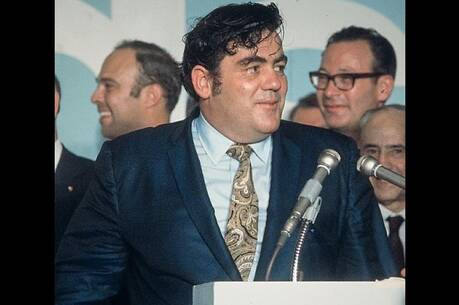Why the gods should be fully present in history and culture
In the academic world, it sometimes seems untoward for religion scholars to be enthusiastic about religion. It’s fine for specialists in the social sciences or arts to revel in some particular school of thought. But, it seems to me, a certain distance is expected from the religious studies expert—to view the subject of the transcendent as an entirely human construct.
In his new book, History and Presence, the historian Robert A. Orsi argues for an approach to history and culture “with the gods fully present.” The norm of modern discourse is the opposite, he says. It assumes the absence of the transcendent. And so at the outset of his book, Orsi asks the reader “to withhold from absence the intellectual, ethical and spiritual prestige modernity gives to it.”
The reader’s reward is an intellectual and spiritual adventure with a guide who has a keen eye for the inbreaking of the sacred in 20th- and 21st-century Catholic America. Anyone with a deep interest in what it means to be Catholic amid U.S. secular culture will find much to ponder in these pages.
The trail leads from the Reformation debate over the real presence of Christ in the Eucharist to a concluding chapter on the clergy sexual abuse crisis, a fascinating section based on numerous interviews with survivors about their faith lives.
Orsi traces the rise of “absence” to the religious debates of the 16th century. The Catholic belief in the presence of Christ in the consecrated host influenced the medieval Catholic imagination, Orsi writes, and is reflected in the cult of the Blessed Virgin and the saints and attendant miracles, apparitions, shrines and devotions.
Protestant reformers rejected these “popish” practices, and the question of a sacred presence or absence in the Eucharist and in Catholic devotions became the source of hatred, vitriol and even warfare. “Modernity exists under the sign of absence,” Orsi writes. “The reimagining of the relationship between God and humans that commenced in the early 16th century introduced an ontological fault line that would eventually run through all of modernity.”
This battle echoes in 20th-century America. In his opening chapter, Orsi recounts the novella Tony, written in 1933 by Thomas B. Chetwood, S.J., regent of the Georgetown University School of Law. Tony is a tough 10-year-old Irish-Italian street urchin who had made his first Communion a year earlier. A gang of Protestant boys catches him drowning a kitten in the river and as punishment ties him up and hangs him upside down, trying to force him to say he is a “Dago an’ a Republican an’ a Protestant.” Dangling over the river, he balks at saying he is a Protestant because “I can’t say Y’ere not there”—meaning that to say he is a Protestant would be to deny the real presence of Christ in the Eucharist. He dies a tortured death, repeating those words—a martyr.
Tony’s story suggests that American Catholicism is at once alienated and confident and shows how the church’s worldview revolves “around the real presence of Christ in the Eucharist, of the holy in the material, of the supernatural in the natural,” Orsi writes.
In the chapters that follow, Orsi conducts a tour of how American Catholics have connected to the sacred through Marian apparitions and devotion to the Sacred Heart and saints. He does this in some cases through interviews that reveal highly personal stories of suffering and devotion.
One story involves an Arizona woman he calls Natalie. In an interview, she told of how she grew up trapped in a household in which her stepfather sexually abused her from a young age. She told the priest in her first confession about the abuse—the stepfather had threatened to kill her if she did—and the confessor replied there was nothing he could do. So Natalie started to confide in a statue of the Sacred Heart of Jesus. Five years later, the stepfather was killed in a mining accident.
Orsi deftly uses these stories to explore his idea of “presence.” He also shows a sharp eye for detail as he explores mid-century printed material aimed at children—holy cards that use 3D images, “as if such cards were reaching toward presence, in excess of print itself.” Also, devotional magazines, catechisms, manuals for religious educators, missals and a gory comic-book account of St. Maria Goretti’s life.
There is an enjoyable side trip into the metaphysics of Catholic school penmanship, since, as Orsi reports, Sister Mary Leo wrote in 1943 in the Journal of Religious Instruction, “there is no subject in the curriculum that affords a better chance to teach and inculcate in the minds of little ones respect for the persons and things about which they write.”
Reading Orsi’s vivid descriptions of the world of the Catholic school helped me to see my own schooling in the 1960s with greater clarity. The bottom line is that “as a result of their religious formation, Catholic children possessed a kind of internal comic book of the supernatural in which they were characters, too.”
How terribly debilitating, then, when a priest—who consecrates the host, who stands “at one degree of separation from God”—abuses the body of a child who has been formed with a Catholic sense for the presence of the sacred, rooted in the Eucharist. Even though so much has been written on this scandal, the context Orsi offers adds a great deal to the discussion.
This context of the “presence of the gods,” Orsi argues more broadly, is missing in the study of religion and history. Without it, he concludes, scholars “will miss the empirical reality of religion in contemporary affairs and they will fail to understand much of human life.”
This article also appeared in print, under the headline “The Age of Absence,” in the September 19, 2016, issue.








